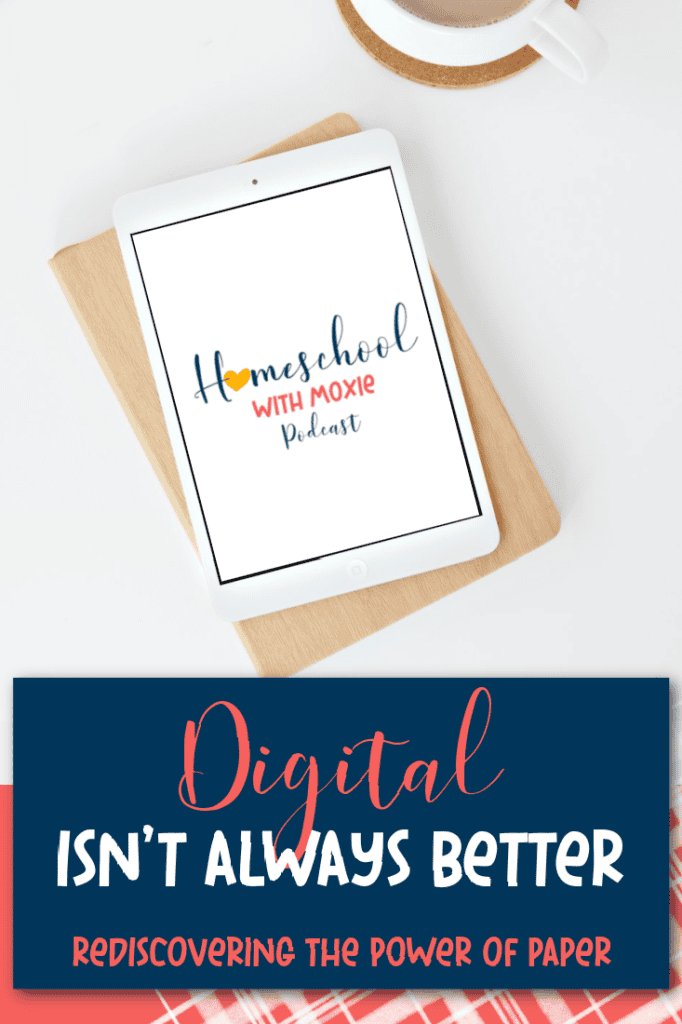Are screens making learning shallower? In this episode, we explore why handwriting and reading on paper boost comprehension and brain engagement—and why it’s time to bring pencils and printed books back into homeschool routines.

My posts include affiliate links.
Screens have definitely taken over many homeschools. As more and more curriculum becomes available as a digital option, parents find themselves working while homeschooling, or moms struggle to homeschool multiple ages and grades – homeschooling on screens has grown.
But research is now showing what many of us thought to be true: Handwriting and reading on paper activate deeper brain function and support real learning.
So, let’s bring back the paper and pencils. This isn’t just nostalgia – but data-driven.
318. Digital Isn’t Always Better: Rediscovering the Power of Paper
Today we’re diving into something that’s quietly disappearing in our tech-filled homeschool days: handwriting and reading on paper.
In my opinion, with the rise of online courses and constant screen time, our kids are losing something important. It’s time to bring back the paper, the pencils, and the printed books. Let’s talk about why it matters—and how to bring it back into your homeschool.
Listen to episode 318 of the Homeschool with Moxie Podcast.
(coming soon!)
The Brain Science Behind Handwriting
When I was reviewing IEW’s Cursive Knowledge, I came upon this interesting quote: “writers need to access multiple areas of the brain.“
That’s echoed in a Psychology Today article called ‘Why Writing by Hand Could Make You Smarter,’ which explains how handwriting activates more of the brain and leads to better thinking and memory.
We’ve seen this recently in our own homeschooling.
My high schooler started using Khan Academy for his high school math courses. At first, he really struggled with understanding and remembering the content. Then we realized why. He was watching the videos and answering the online questions and problems. However, he couldn’t master the quizzes or retain the knowledge in his memory. It all came down to not writing anything on paper!
Yes – it really was that simple. So we came up with a solution that worked. He’d use a notebook and colored pens and take notes, work out problems, and write down the content as he watched the instructional video and as he worked through the math problems. He would use old-fashioned paper and pencils and pens to work out the math. Then, he could enter his answer on the computer.
Just this simple change alone allowed my teen to master the content.
Research shows that handwriting improves memory, learning retention, and cognitive processing. It activates neural pathways that typing doesn’t engage.
Hold that thought.
Reading Comprehension: Screens vs. Paper
And it’s not just writing. A massive study—over 170,000 participants—shows we actually learn and comprehend more when reading from paper than from screens. It’s called the “paper advantage,” and it’s only grown over time.
In the 2023 Educational Research Review meta-analysis of 54 studies with 171,000+ participants, we learn that paper reading leads to better comprehension—especially with informational texts. This is why you should try to use real books – living books – when you’re studying science, history, literature, and more in your homeschool.
The Hidden Downsides of Digital Learning
Yes, digital platforms definitely bring convenience to homeschooling. This is especially true if you’re struggling to teach multiple ages or you’re working on the side.
But you need to know as a homeschool parent that using screens constantly is not the most engaging strategy to use if you want comprehension and active learning. Digital learning can quickly become a passive habit.
Homeschool-Friendly Ways to Bring Back Handwriting & Paper
Is using screens or digital resources occasionally going to ruin your kids? I don’t think so.
But pro-actively using strategies that engage your kids and encourage active learning is a better choice! This is true even if you’re juggling multiple kids.
Here are some suggestions and strategies for bringing back the handwriting & paper:
- copywork
- narration
- notebooking
- use paper-based curriculum
- take notes when using online instruction
- work math problems out by hand even if using an online platform
Real-World Encouragement
We definitely need to prepare our kids for the real world. So, yes – using some technology is essential and tech has its place. But paper offers something irreplaceable, so consider bringing it back if you’ve lost it.
Consider even a small shift this year – just one subject or one notebook can make a difference. Try it and see!
So what’s the bottom line here? Handwriting and paper aren’t old-fashioned—they’re brain-friendly!